
All right. Here, in several installments, you will be able to read the fascinating chronicle of my six days wandering through the Peloponnesus. Chapter One begins on a bright sunny Friday in Thessaloniki, where I woke up, taught a seventh grade class, taught an eighth grade class, collected my paycheck, stuffed various items in my bags, and headed for the bus station to catch the bus to Athens.
I don't know why, maybe it was nerves brought on by my first full trip alone, but I was convinced that I was not going to catch the bus, or that the bus would be full, or that some other incident would occur to prevent me from setting sail (er, setting wheel?). However, I purchased my ticket, climbed aboard the bus, and well, sat there for six hours. The trip to Athens takes a while. And even when I arrived in Athens I still had two and a half hours to Nafplio ahead of me. So the first day of my travels was not terribly exciting, I suppose. But I saw some pretty terrain on the bus ride, which was nice. I also realized that my geographical knowledge is nil. I kept seeing mountains and thinking "Oh, look! Olympus!" This persisted until we were approaching the greater metropolitan area of Athens. For those of you unfamiliar with Greek geography, this is roughly akin to saying "Oh, look! Mt. Monadnock!" when you are standing in the middle of Manhattan.
Anyway, I arrived in Nafplio at about 11:30pm. Nafplio is a lovely little seaside town in close proximity to Mycenae and Epidavrus, two ancient sites of considerable fame. Nafplio is also known for being a lovely weekend resort, and as this was the weekend, I was a bit nervous about finding accomodation. Unfortunately, many of the smaller hotels were closed for the night by the time I arrived; there was nobody at the reception desk to give me a room. I ended up at a place near the bus station that was very clean, very cheap, very friendly, and had absolutely atmosphere whatsover. That was unfortunate, in a way; Nafplio is known for being a perfect romantic getaway, and some romance would have been nice. But I settled for CNN, which was also a definite novelty in my otherwise television-free life.
The next morning I strolled through acronafplia, an old castle on a hill right in the middle of town, and then caught the bus to ancient Mycenae.
 Here's the view from acronafplia.
Here's the view from acronafplia.Mycenae was the center of the Mycenean kingdom, where Agamemnon supposedly ruled, at least until he went to war at Troy and sacrificed his daughter, came home with a lover, and was killed by his wife Klytemnestra and her lover who were consequently both murdered by Electra and Orestes, the children of the troubled marriage, who were victorious until Orestes went insane from all the bloodshed and had to go find some gods to redeem him. Turns out they were all cursed because their ancestor killed someone named Pelops and then served him to the gods at a banquet. I know this because back in high school I was in a play entitled 'The Libation Bearers', which tells the story of Electra and Orestes. The story is also in the Odyssey, I believe.
Ultimately, I am sure we don't know how much of the story is truth and how much is myth, but I do think that rather adds to the appeal of the whole thing.
You enter ancient Mycenae through the famous Lion Gate, which I am pretty sure I saw pictures of in various English and History classes throughout middle school, high school and college.
 However, nobody but me seems to remember having seen these pictures, which suggests one of two things: 1) I went to schools with particularly good visual classroom aids, or, perhaps, 2) I was the only one paying attention in the aforementioned classrooms. Either one seems a distinct possibility. Here's the Lion Gate, anyway, and you can take a look for yourself. and see if your memory is jogged.
However, nobody but me seems to remember having seen these pictures, which suggests one of two things: 1) I went to schools with particularly good visual classroom aids, or, perhaps, 2) I was the only one paying attention in the aforementioned classrooms. Either one seems a distinct possibility. Here's the Lion Gate, anyway, and you can take a look for yourself. and see if your memory is jogged.The Lions, actually, may not be lions after all; that's what Howard, my fellow American tourist, told me. Indeed, if you look closely you see that they really do not have heads, so all we can say for sure is that they are large mammals. Large Mammal Gate; it sounds like something that might exist at the Bronx Zoo. Of course, if they are sphinxes, I'm not sure if they are mammals or what. Are sphinxes mammals? I guess they are hybrids of other mammals, so in a sense, yes, they are.
Here are some pictures of the Mycenean ruins that lie beyond the gate. There's an entire palace to be seen, including everything from tombs to an underground water cistern to things that nobody can really identify. The site was excavated by Heinrich Schliemann some years ago; does the name sound familiar? We discussed him in school, but maybe that was also when I was the only one paying attention. Schliemann is the one who found the famous death mask of Agamemnon, which you have seen pictures of, I'll bet. Of course, it seems that the mask is only known as the death mask of Agamemnon because Schliemann decreed it to be so; nobody knows for sure if it was Agamemnon or just some bloke. (I love the word 'bloke', don't you? It's much more fun than 'guy')
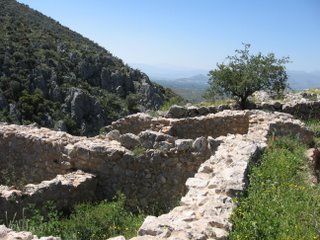

I usually try to remain somewhat discreet about my picture-taking, as I don't like to be an obvious obnoxious tourist. But at Mycenae, the only people present are tourists and dead people, and as I'd prefer to belong to the former group, I didn't feel too self conscious about taking constant snapshots. Here's one of the tombs. I believe this is the tomb of Aegisthus, who was the lover of Klytemnestra, whose name may or may not be spelled in that particular way.
 These tombs are built with a sort of beehive shaped roof inside. They are totally different than the northern Macedonian tombs that you can see at Vergina. Also, I'm exaggerating about the dead people. There are no dead people inside, although presumably there used to be some. Mycenae has a variety of tombs for various members of the royal family, because that's what happens when you keep murdering people; you have to built more tombs.
These tombs are built with a sort of beehive shaped roof inside. They are totally different than the northern Macedonian tombs that you can see at Vergina. Also, I'm exaggerating about the dead people. There are no dead people inside, although presumably there used to be some. Mycenae has a variety of tombs for various members of the royal family, because that's what happens when you keep murdering people; you have to built more tombs.I did take a picture of the place where Agamemnon's death mask was found, but for some reason blogger refuses to let me put it up here. Maybe it's afraid of being cursed. That's OK. If you are interested, I am sure that you can find pictures online. That's the thing about ancient ruins; although the temptation to photograph them is overwhelming, you also know that you are taking the same pictures that millions of people have been taking for the past hundred-some years.
After Mycenae, I went back to Nafplio and swapped travel stories with Howard from California, who recommended that I climb up to Palamidi fortress, an old Venetian structure way the hell up on the top of a cliff overlooking Nafplio. I took his advice and headed up there. It was something of a climb. I later read that there are supposedly 999 steps up there, although that may be a myth. I sure didn't count.
The Venetians, as you may or may not know, occupied portions of southern Greece for a while, way back before the Ottomans took over. I don't know much about the Venetian occupation except that it created some awfully nice architecture, and Palamidi fortress was no exception. It's got all sorts of mysterious nooks and crannies, crumbling walls, hidden bastions that seem to go on forever across the hillside, towers and lookout posts. It's also got a great view, which is a nice reward for a sweaty tourist, and was a nice advantage for the Venetians if someone was attacking.
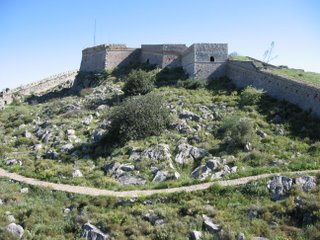 Of course, I think one would have to be in awfully good shape to attack Palamidi. I go running a whole lot, but by the time I got up there I was still pretty sweaty and tired, and my calves were absolutely furious at me the following day. It was at Palamidi that I began taking pictures of myself; I had climbed all the way up there, and the view was gorgeous, and I would be damned if I was going to let that photo opportunity by. After all, I wouldn't want anyone to think that I'm still hiding out in that basement apartment in Iowa, stealing pictures from google image searches and making random stuff up. Unfortunately, you are still going to have to take my word for it, because blogger also refuses to put this picture up. Blogger is in a rotten mood today. But trust me; the photo exists. I made it up there, I have a sweaty bedraggled look to prove it and everything.
Of course, I think one would have to be in awfully good shape to attack Palamidi. I go running a whole lot, but by the time I got up there I was still pretty sweaty and tired, and my calves were absolutely furious at me the following day. It was at Palamidi that I began taking pictures of myself; I had climbed all the way up there, and the view was gorgeous, and I would be damned if I was going to let that photo opportunity by. After all, I wouldn't want anyone to think that I'm still hiding out in that basement apartment in Iowa, stealing pictures from google image searches and making random stuff up. Unfortunately, you are still going to have to take my word for it, because blogger also refuses to put this picture up. Blogger is in a rotten mood today. But trust me; the photo exists. I made it up there, I have a sweaty bedraggled look to prove it and everything.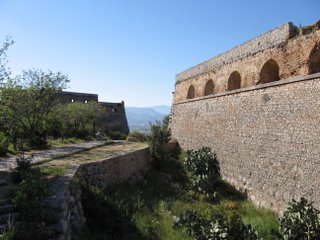

After Palamidi, I opened my Lonely Planet to the Nafplio map to locate a shop described as having the best gelato outside of Italy. I am a sucker for good gelato, especially on a hot afternoon after climbing a fortress. On the way I ran across a large assortment of souvenir shops and tour groups wandering through the old town area. All of this tourism was a big change; Thessaloniki really doesn't attract tourists much, and it was something of a shock to be surrounded by Americans and to be greeted with "Hello!" instead of "Γεια σασ!" "How can they tell I'm American?" I wondered indignantly. Was it my clothes? My manner? My wide-eyed expression? (I've seen that expression on a lot of people in Manhattan; you always know a tourist in Times Square because they are looking up and walking slow.) Maybe it was the Lonely Planet guide tucked under my arm. That's a pretty big tip-off.
On my way to the gelato shop I stumbled across something known as the komboloi museum. Komboloi are called worry beads in English; they are often made of amber, and strung together on a piece of string. Men seem to carry them more than women, particularly older men. If you look closely, you'll see that many people have them tucked away in one hand, and you'll often hear them clicking and clacking back and forth in public places.
Well, the worry bead museum was tiny, but educational; it had a display of komboloi ranging back hundreds of years, and explained that the Greek komboloi developed from Muslim and Buddhist religious beads. In fact, this is also where the Catholic rosary came from, apparently, and there were several of those on display as well. However, Greek worry beads are unique because they are not a religious tradition, more of a nervous habit than a prayer aid.
Well, they may not be religious, but that doesn't mean that there are not worry bead fanatics and worry bead fundamentalists. My museum ticket came with a little booklet written by the museum founder, a passionate worry bead lover who insists that real komboloi must be made with certain materials; bone, amber, coral, wood, or other things that were once alive. He insists that metal worry beads are a terrible corruption of the komboloi tradition, and urges true worry bead users to join the "Order of the Komboloi", to take on the "sacred duty" of a "preacher", to fight agaist the "barbarous manufacturers", and "pimps" who have "tarted up" the komboloi. I find all of this a little bit mystifying, and the "Order of the Komboloi" sounds to me like a group of Greek wizards casting spells against Lord Voldemort. But we all need our passions in life, I suppose, and most of mine are hardly sensible either, come to think of it.
The end of the story is, I got my gelato and learned a bit about komboloi tradition before meeting Howard for dinner in the old town. (Howard if, you are reading this, email me! I lost your email address, but I would love to know how you are doing and how your trip turned out.) We alo caught a glimpse of the lovely Nafplio sky at nightfall.
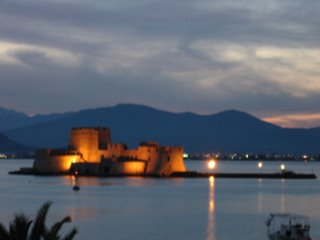
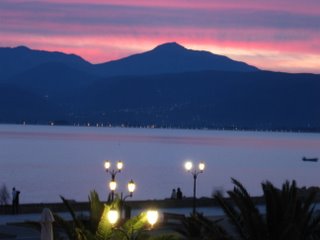
The next day I was up early again, and off to see the ancient site of Epidaurus (pronounced Epidavrus), where there is a magnificent ancient theatre with excellent acoustics. I mean, these people made modern day sound systems practically obsolete. You could hear people on the stage loud and clear, even up in the very top row.
 In this picture, taken from the top, you can see a group clustered together on the stage, way down there. They were singing "Dona Nobis Pacem", and it was lovely. And I could hear them! There were a fair number of performers giving those acoustics a try; I was tempted, myself, even though my high school drama days are past. However, singing is not my forte and I had no impressive monologue to impart. And when you voice is going to reach several hundred tourists in a setting like that, well, you want to be impressive.
In this picture, taken from the top, you can see a group clustered together on the stage, way down there. They were singing "Dona Nobis Pacem", and it was lovely. And I could hear them! There were a fair number of performers giving those acoustics a try; I was tempted, myself, even though my high school drama days are past. However, singing is not my forte and I had no impressive monologue to impart. And when you voice is going to reach several hundred tourists in a setting like that, well, you want to be impressive.The theatre is the most exciting part of Epidaurus, but they also have a nice little museum, and an ancient sanctuary where people came to be healed and worship the God Asklepios.
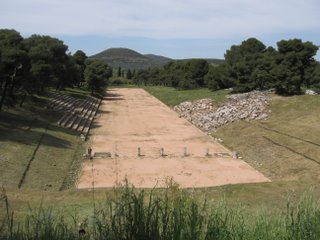 The sanctuary included this stadium, which I thought was definitely photo-worthy.
The sanctuary included this stadium, which I thought was definitely photo-worthy.I somehow missed the bus back to Nafplio, although I personally suspect that it did not arrive at all, as I was there ten minutes early, and did not see any bus leave the premises, and neither did several other people who were waiting. Fortunately, I met a study abroad student and her family who were in the same predicament, and they were nice enough to let me tag along on their cab ride back to Nafplio, where I spent several more hours eating gelato and browsing through souvenirs before catching the bus to Tripoli en route to Sparta. And that is where I will leave you for the time being. Up Next; Byzantine ruins.


1 comment:
Hi Emily, I just found your fantastic blog. I hope you didn't get stuck in the ancient world. I'm a NYer too, fan of Shakespeare and Joyce, but primarily I study ancient Greek. Thanks for great photos and insightful descriptions. Now I have to go to Greece! ~N
Post a Comment